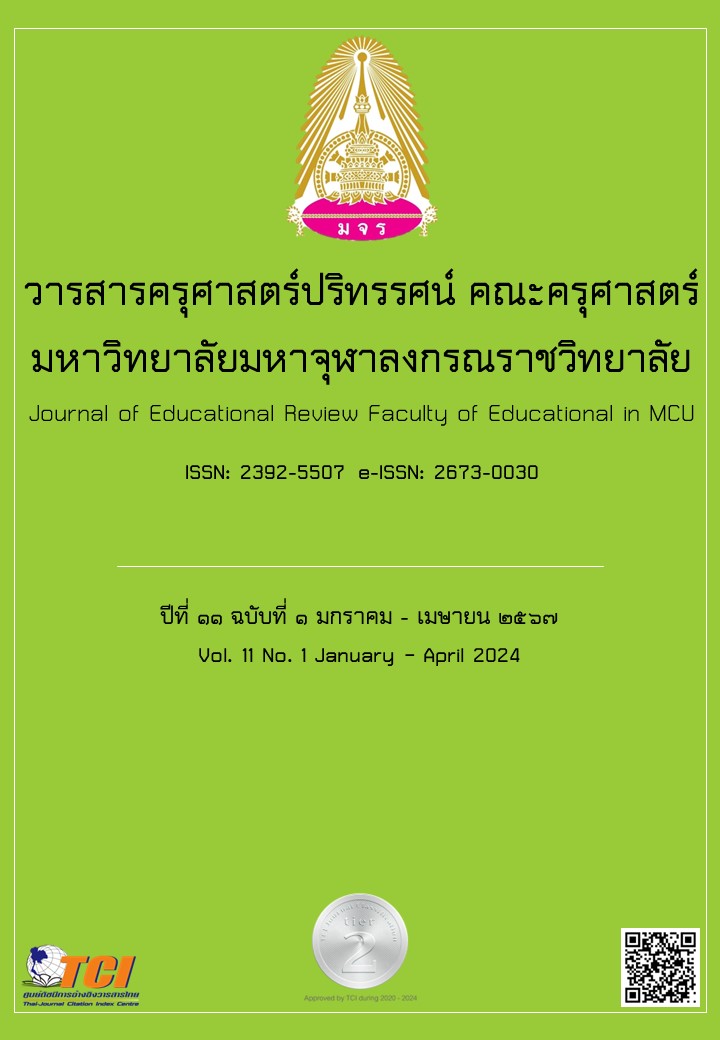DRIVING THE BUDDHIST LEARNING INNOVATION AREA
Main Article Content
Abstract
The objectives of this research article were to 1) study the model for driving the Buddhist learning innovation areas, 2) develop the driving of Buddhist learning innovation areas, 3) promote the driving Buddhist learning innovation areas. Using qualitative research methods and action research as an important part of every step of the research process. Related concept and theoretical documents were studied. Data were analyzed by content analysis. Interviews with 120 key informants, including administrators, faculty, staff, and students of the Faculty of Education at Mahachulalongkornrajavidyalaya University, by interview form. Data were analyzed by content analysis. A small group discussions with 13 key informants including administrators, faculty, staff, students in the Faculty of Education, and those involved in the development of innovative Buddhist learning area. The research tool was a set of activities to analyze data by content analysis. The research results found that: The model for driving the Buddhist learning innovation area had been developed and adjusted according to the current situation to be compatible with the effective learning process. This could be used to exchange knowledge with other educational institutions including an innovative area for learning the Buddhist way. There was a plan for organizing teaching and learning, implementing the plan and organizing the measurement and evaluation of learning management. It had a format that was easy for students to understand, focusing on activities to drive efficiency, teaching and learning should be made easily accessible, providing opportunities for all sectors to participate, consisting of 1) policy-driven, 2) spatial-driven, 3) activity-driven, 4) technology-driven. In developing and driving the model for driving the Buddhist learning innovation area in educational institutions, there was a clear model to drive the Buddhist school by using the same format to develop students' learning to learn Buddhism effectively, a Buddhist network should be created to coordinate and cooperate.
Article Details

This work is licensed under a Creative Commons Attribution-NonCommercial-NoDerivatives 4.0 International License.
ทัศนะและความคิดเห็นที่ปรากฏในบทความในวารสารฉบับนี้ถือเป็นความรับผิดชอบของผู้เขียนบทความนั้นเพียงผู้เดียว และไม่ถือเป็นทัศนะและความรับผิดชอบของกองบรรณาธิการ
กองบรรณาธิการขอสงวนสิทธิ์ในการคัดเลือกบทความลงตีพิมพ์และจะแจ้งให้เจ้าของบทความทราบหลังจากผู้ประเมินบทความตรวจอ่านบทความแล้ว
ต้นฉบับที่ได้รับการตีพิมพ์ในวารสารครุศาสตร์ปริทรรศน์ คณะครุศาสตร์ มหาวิทยาลัยมหาจุฬาลงกรณราชวิทยาลัย ถือเป็นกรรมสิทธิ์ของคณะครุศาสตร์ มหาวิทยาลัยมหาจุฬาลงกรณราชวิทยาลัย ห้ามนำข้อความทั้งหมดหรือบางส่วนไปพิมพ์ซ้ำ เว้นเสียแต่ว่าจะได้รับอนุญาตจากมหาวิทยาลัยฯ เป็นลายลักษณ์อักษร
References
กระทรวงศึกษาธิการ. (2551). หลักสูตรแกนกลางการศึกษาขั้นพื้นฐานพุทธศักราช 2551. กรุงเทพมหานคร: โรงพิมพ์ชุมนุมสหกรณ์แห่งประเทศไทย.
พรรณี สวนเพลง. (2554). อินเทอร์เน็ตบรอดคาสติ้งนวัตกรรมสร้างสรรค์ด้านการศึกษา เพื่อพัฒนาครูผู้ดูแลเด็กเล็กในศูนย์พัฒนาเด็กทั่วประเทศไทย ระยะที่ 2. รายงานการวิจัย. มหาวิทยาลัยราชภัฏสวนดุสิต.
พระราชบัญญัติพื้นที่นวัตกรรมการศึกษา พ.ศ. 2562. (2562). ราชกิจจานุเบกษา เล่ม 136 ตอนที่ 56 ก หน้า 102 (30 เม.ย. 2562).
พิชิต ฤทธิ์จรูญ. (2550). หลักการวัดและประเมิลผลการศึกษา. พิมพครั้งที่ 4. กรุงเทพมหานคร: เฮาสออฟ เคอรมิสท.
ไพลดา อริรุทธพาณิชย์. (2552). การพัฒนาครูด้านการวิจัยในชั้นเรียนด้วยชุดฝึกอบรมการวิจัยในชั้นเรียน. วิทยานิพนธ์ครุศาสตรมหาบัณฑิต. มหาวิทยาลัยราชภัฏพระนคร.
วันเพ็ง ระวิพันธ์ และคณะ. (2562). แนวทางการใช้นวัตกรรมและเทคโนโลยีสารสนเทศด้านการจัดการเรียนรู้ของครูตามนโยบาย ไทยแลนด์ 4.0 สำนักงานเขตพื้นที่การศึกษาประถมศึกษา พระนครศรีอยุธยา เขต 2. วารสารครุศาสตร์ปริทรรศน์ คณะครุศาสตร์ มหาวิทยาลัยมหาจุฬาลงกรณราชวิทยาลัย. 6(1). 116-128.
สมเจตน์ ผิวทองงาม. (2566). การเรียนรู้ในพระพุทธศาสนา: ทฤษฎี และการนําไปประยุกต์ใช้. วารสารสมาคมพัฒนาวิชาชีพการบริหารการศึกษาแห่งประเทศไทย. 5(4). 249-266.
สำนักงานบริหารพื้นที่นวัตกรรม สำนักงานคณะกรรมการการศึกษาขั้นพื้นฐาน. (2565). พื้นที่นวัตกรรมการศึกษาทำนอกกรอบพัฒนาสมรรถนะเด็ก. แหล่งที่มา https://www.sobkroo.com/articledetail.asp?id=1035. สืบค้นเมื่อ 25 ต.ค. 2565.
สุทธิพงศ์ บุญผดุง. (2558). การพัฒนาแหล่งเรียนรู้ในโรงเรียน สังกัดสำนักงานเขตพื้นที่การศึกษาประถมศึกษานครนายก. วิทยานิพนธ์ครุศาสตรมหาบัณฑิต. มหาวิทยาลัยราชภัฏสวนสุนันทา.


